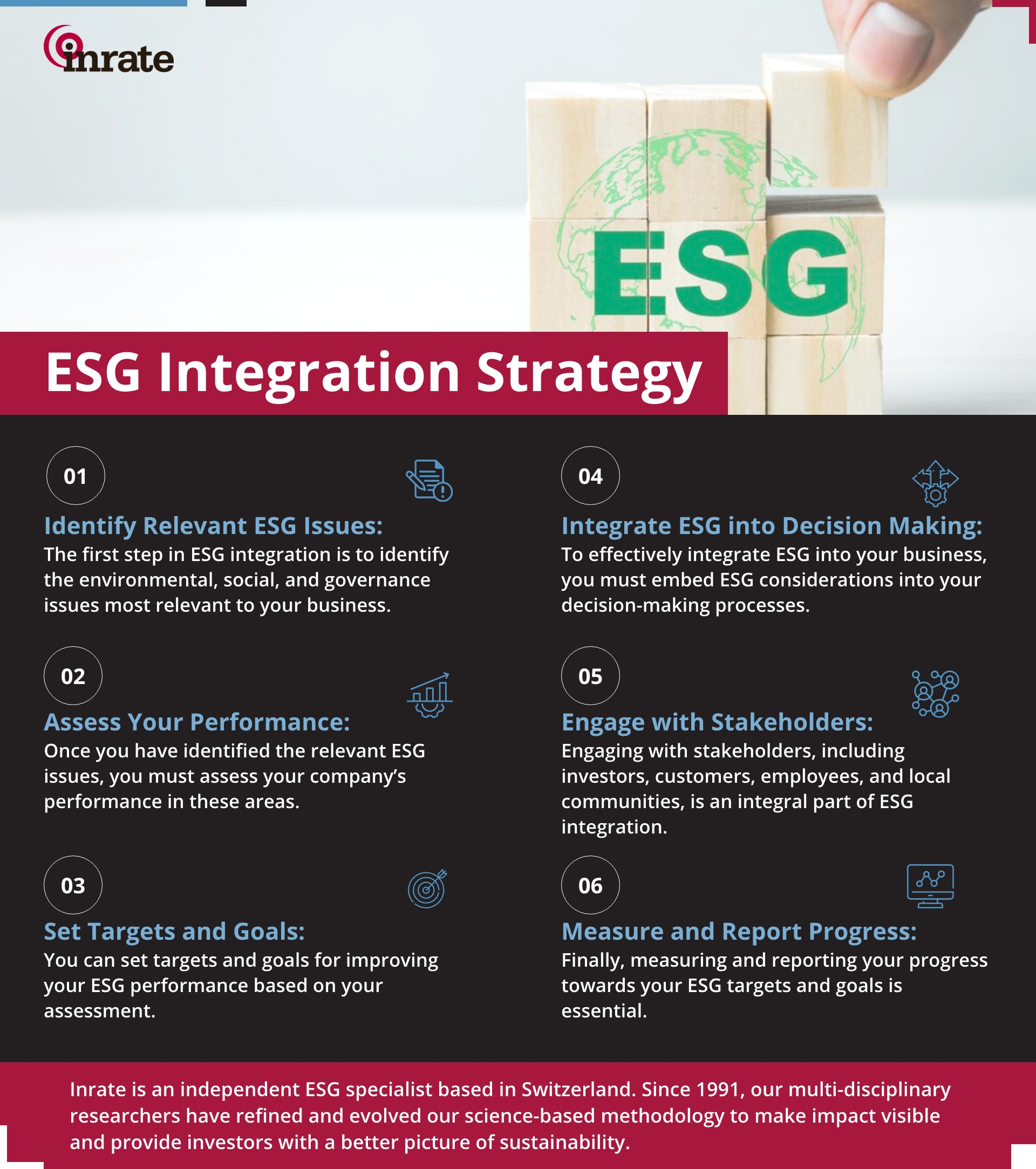How To Integrate ESG Into Business Strategy?
Environmental, social, and governance (ESG) factors have grown significantly for corporations in recent years. ESG is a framework for assessing how a firm affects society and the environment and how it is governed. ESG principles may be incorporated into a company’s strategy to reduce risks, provide long-term value, and foster stakeholder trust.
This blog post will discuss how to include ESG into a business strategy, the advantages of doing so, important factors to think about, and achievable steps businesses can take to incorporate ESG principles into their operations.
How Do I Integrate ESG Into My Business?
Businesses are under significant pressure to address their influence on the environment, society, and governance as the need for sustainable development becomes more widely recognized. Yet, adopting ESG may be intimidating for many business owners.
How to begin? What are the most important factors? How do you ensure that you’re following the law and having a positive effect?
Here are some helpful tips on incorporating ESG into your company, along with steps that can be taken to evaluate your current ESG performance, interact with stakeholders, create goals, and track your progress. You can take concrete action by taking the necessary steps to make your company more sustainable and responsible and position yourself for long-term success.
ESG Integration Strategy
ESG integration strategies may be helpful for businesses to evaluate and control their influence on society, the environment, and governance. Companies may identify risks and opportunities, show their commitment to sustainability, and ultimately generate long-term value by adopting ESG principles into their business strategy. Here is a step-by-step process for incorporating ESG into your company:

-
Identify Relevant ESG Issues:
Finding the environmental, social, and governance factors that influence your company and its stakeholders is the first step in identifying significant ESG concerns. This may be achieved by carrying out a materiality assessment, which entails talking to stakeholders about their expectations and reservations and assessing the opportunities and risks related to various ESG issues.
The evaluation will likely consider carbon emissions, water use, employee diversity, human rights, supply chain ethics, data protection, and board composition. The first step in creating an effective ESG strategy suited to your business and stakeholders’ expectations is identifying pertinent ESG challenges.
-
Assess Your Performance:
Your current ESG performance in the areas you have specified as relevant will be assessed when determining how well you performed. Data collection on your social practices, governance structures, and environmental consequences can be part of this process. Your performance can then be compared to relevant standards and regulations.
The evaluation process may also involve engaging stakeholders for their opinions on your ESG performance and desired modifications. You may find your ESG practices’ strengths and shortcomings and potential areas for growth by evaluating your performance. You may utilize this data to create precise objectives for your ESG integration strategy.
-
Set Targets and Goals:
Defining targets and goals entails creating precise, quantifiable objectives to boost your ESG performance in the areas you have determined to be pertinent. This can entail lowering your carbon emissions by a specific percentage, broadening the diversity of your workforce, upgrading the sustainability of your supply chain, or improving your data privacy protocols.
Your assessment of your current ESG performance and stakeholder expectations should be the foundation for the targets and goals. They should also align with your overall company strategy, be ambitious yet doable, and be comprehensive. By establishing objectives, you can lay out a clear plan for enhancing your ESG performance and show stakeholders your sustainability dedication.
-
Integrate ESG into Decision-Making:
While making decisions, it’s crucial to take ESG factors into account. This means incorporating ESG factors into your entire business strategy and decision-making processes. It might entail creating an ESG-centered business strategy, integrating sustainability measures into performance assessments, and assessing ESG risks and opportunities when making investments or mergers and acquisitions.
You can ensure your ESG goals and targets align with your company strategy. When making all important choices, sustainability factors are considered by incorporating ESG into decision-making. This can assist you in controlling ESG risks and enhancing your ESG performance while also helping you build long-term value for your company.
-
Engage with Stakeholders:
Engaging stakeholders entails communicating with and working with pertinent groups, such as investors, clients, employees, suppliers, and local communities, to understand their expectations and reservations regarding ESG issues fully. Creating sustainability reports or other communication material and conducting polls, meetings, or focus groups are necessary.
By interacting with stakeholders, you may get important information about their opinions of your ESG performance and identify areas that need to be improved. You may also win over stakeholders’ confidence and credibility by showcasing your dedication to accountability and transparency. Interacting with stakeholders may assist you in creating more successful ESG initiatives, aligning with stakeholder expectations, and providing value for all parties.
-
Measure and Report Progress:
Monitoring and communicating your ESG performance with stakeholders over time is part of measuring and reporting progress. This might entail utilizing measurements and indicators like carbon emissions, employee turnover, or supplier diversity to assess your progress toward your ESG targets or goals. Moreover, you can be required to provide updates on your ESG performance through a variety of mediums, including investor presentations, annual reports, and sustainability reports.
You can demonstrate your devotion to ESG performance and transparency by tracking your progress and reporting it to stakeholders. You can also show them how you add value in the long run. You may also find areas for improvement and gradually enhance your ESG initiatives by tracking and reporting your progress.

In Conclusion,
integrating ESG considerations into business strategy is becoming increasingly important for companies to remain competitive and resilient in changing stakeholder expectations and market pressures. A step-by-step ESG integration process involves identifying relevant ESG issues, assessing current ESG performance, setting targets and goals, integrating ESG into decision-making, engaging with stakeholders, and measuring and reporting progress.
For businesses looking for ESG consulting services, Inrate is a trusted provider offering various solutions to help companies implement effective ESG strategies. Inrate’s expertise and experience can help businesses navigate the complex ESG landscape and integrate sustainability considerations into their operations while demonstrating their commitment to ESG performance and transparency to stakeholders.
FAQs
1. What is ESG Integration Approach?
The ESG integration approach aims to manage risks and produce long-term value for stakeholders by integrating environmental, social, and governance (ESG) factors into a company’s decision-making processes and overall business strategy.
Corporate rating, which evaluates businesses based on their ESG performance, is a crucial component of the ESG integration approach. Corporate rating agencies assess a company’s ESG performance using a variety of frameworks and criteria, including the company’s carbon emissions, workforce diversity, board composition, and supply chain sustainability. Investors and stakeholders can use these ratings to help them decide where to invest their money or which businesses to work with.
Want to know how Inrate rates companies? See our methodology here.
2. How To Integrate ESG and Transform Your Company for the Better?
Integrating ESG and transforming your company for the better involves developing and implementing an ESG implementation strategy that aligns with your business goals and values. You refer to the ESG integration strategy mentioned above to implement ESG into your business.





